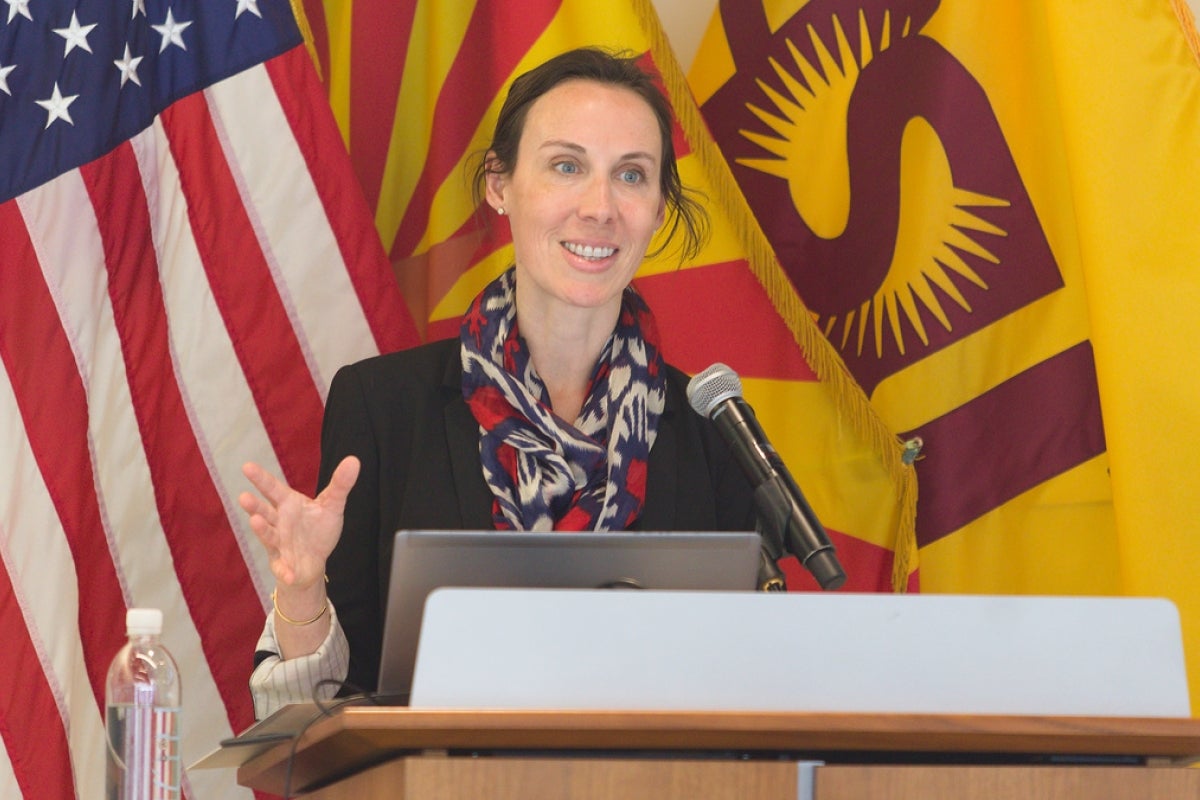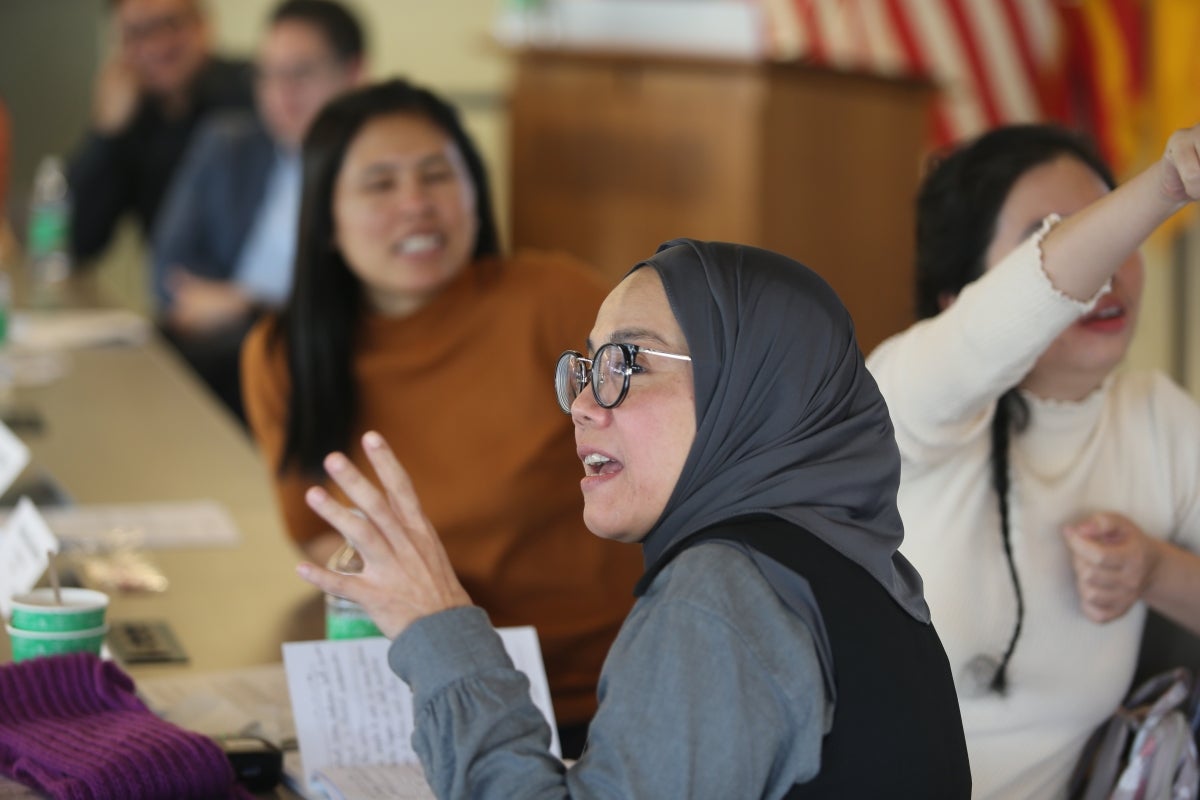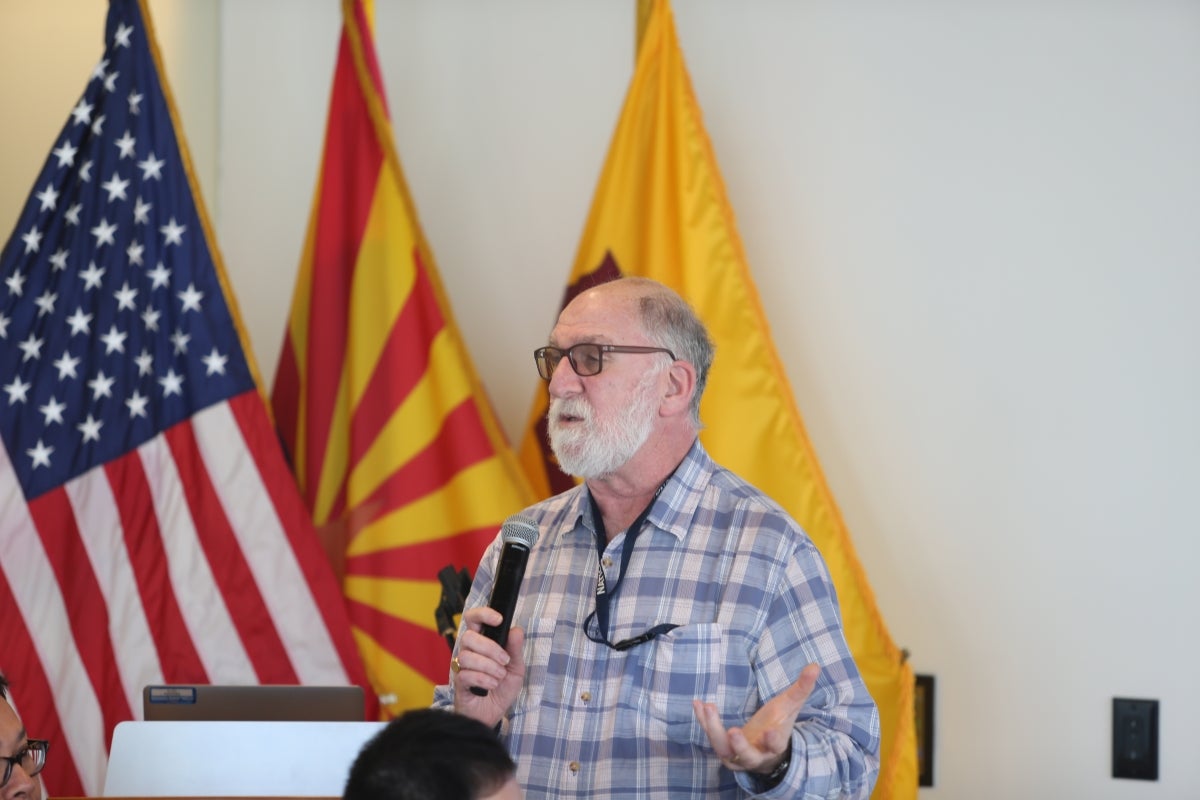US-ASEAN Center hosts tour centering environmental biotechnology program

A group presents its plan to confront a hypothetical binational water contamination scenario in the Designing Sustainable Water Treatment Projects seminar, held as part of the ASEAN Science, Technology, and Innovation Cooperation Program study tour on March 12. Photo courtesy Hager Sharp
As Arizona State University kicked off this year’s U.S.-ASEAN Science, Technology, and Innovation Cooperation, or STIC, Program study tour, the room was filled with quiet anticipation — each of the 21 hand-picked participants looking forward to the potential of what the next week would bring.
Last year’s program centered on cybersecurity. This year’s tour, which is a flagship staple of the STIC Program, focused on environmental biotechnology.
“You have a very fruitful week ahead of you, filled with exciting discussions, site visits, touring the largest advanced wastewater treatment plants in the world, hearing from experts on policy implications on agriculture and food security, and more,” said Holly Lindquist Thomas, director of the Office of Multilateral Affairs in the Pacific Bureau of the U.S. Department of State, in her opening ceremony speech. “We appreciate your dedication of time, energy, and talent throughout this week, and we strongly believe that you’re going to make Southeast Asia a better place.”
Kathleen Stevens, foreign affairs officer, Office of Science and Tech Cooperation at the U.S. Department of State, opened the week with a keynote speech. Stevens mentioned multiple United States country-wide efforts to support environmental biotechnology, like President Biden’s Executive Order on Advancing Biotechnology and Biomanufacturing Innovation for a Sustainable, Safe, and Secure American Bioeconomy.
“This pivotal policy initiative is truly a whole of government effort to identify opportunities and address key challenges within the bio economy,” Stevens said. “I really emphasize 'whole of government' because it took us years, several administrations, to finalize this executive order. I think it really calls out the importance of bringing together all sectors of society.”
This year’s tour was centered in the new U.S.-ASEAN Center at ASU in Washington, D.C., just months after its inauguration.
“The United States is proud to be a close friend to ASEAN, and our relationship is strong,” Thomas said. “Our countries are now more united than ever, committed to working together to tackle shared challenges and build opportunities for our combined one billion (people). United States agrees with ASEAN countries that science, technology, and innovation are key drivers of economic growth and regional integration. We stand ready to support in achieving these goals, including our support to concrete programs like STIC.”
Collaboration and cooperation are the heart of ASU’s U.S.-ASEAN STIC Program, something that Stevens didn’t leave unnoticed.
“These problems have no borders, and biotechnology has the opportunity to provide sustainable solutions,” Stevens said. “We have a shared responsibility to ensure that biotech and bio manufacturing can deliver solutions to our greatest global challenges. Collectively, we need to further educate our public, our private sectors and our policymakers on the positive benefits biotechnology may bring across sectors.”
In the weeklong tour, participants engaged in site visits, networking events, discussions, panels and more.
Modeling cross-national environmental policy and regulation
Day two of the STIC Sustainable Biotechnology Policy Study Tour culminated in a group discussion, "Designing Sustainable Water Treatment Projects," led by Clifford Weil, program director for the National Science Foundation’s Division of Molecular and Cellular Biosciences.
Weil, a former Purdue University professor whose focus was on genetics, molecular biology and genomics of plants, facilitated groups of representatives from the ASEAN member states who worked together on an activity to address a hypothetical water contamination issue shared between two neighboring nations. He explained why water contamination was selected to model how cross-national environmental policy is developed.
“Water and food resources have historically been the things people fight over more than anything else.”
Each group of representatives from different ASEAN member states included specialists in various fields such as engineering, policy, microbiology, and biochemistry. They presented their plans to address their selected scenario along with the corresponding real-world considerations and justifications.
The groups’ science and engineering specialists detailed how they would create sustainable policies, strengthen infrastructure, and promote water conservation, while the policy specialists described the two fictional nations’ plans for negotiating a mutually beneficial solution and promoting public awareness of the problem.
Weil emphasized how observations taken from the exercise can be applied to ASEAN member states working to address environmental issues at home.
“Whenever there are these negotiations, it’s a really good thing to remember that there are valuable perspectives to be had from the public sector, the private sector, the large government organizations, to the small individual communities. … Everybody’s got something useful to contribute,” Weil said.
Not 'wasting' any time
Sometimes, the best way to learn how to brainstorm sustainable biotechnological solutions is by analyzing how existing projects work. This was the subject of Wednesday’s second seminar: "Biotechnological Innovations in Waste Management."
Helen Santiago Fink, program manager for the U.S.-ASEAN Smart Cities Partnership, and Joshua Boyce, program manager for the Mekong-U.S. Partnership, each led a presentation that motivated attendees to analyze real, current, sustainable waste management solutions.
Fink’s presentation discussed what makes smart sustainable cities successful, and how the Smart Cities Partnership is managing and mitigating the many variables to better advance the quality of life in urban areas.
One example, which Boyce explored in his presentation, is a Water Smart Engagements Program, or WiSE, in Vientiane, Laos. Specifically, Boyce discussed the Fern Hill Wetland and the Mars Hartdegen Lake, among others.
According to Boyce, one of the biggest challenges for nature-based solutions is that they’re expensive and site specific, especially when compared with a traditional wastewater treatment plant that would generally work in any area.
With nature-based solutions, “you're dealing with living organisms, and you're dealing with native plants. … The flow is going to be different; the outcome is going to be different,” Boyce said. “This means that, in terms of ratification, it's more expensive because you can't 100% say what's going to work.”
However, what nature-based solutions cost up front, they make up in a “huge long-term return” in electricity savings compared with a traditional wastewater treatment plant, Boyce said.
“Like any good nature-based solution, we're going to see amenity benefits, social benefits and economic benefits,” Boyce said. “Nature-based solutions meet a lot of these requirements because it is not something that needs to be managed every day. You don't need an engineer sitting over in artificial wetland, making sure that it works. You need some water quality testing once in a while. It requires no energy. That is a very helpful thing.”
Even outside of the potential economic benefits, nature-based solutions could have great payoffs for climate and erosion concerns, too.
“You can't use only nature-based solutions to solve these problems. But it can be a great complement, which is what we're hoping for,” Boyce said. “This also presents opportunities for conservation and restoration to capture environmental services.”
In the Q&A following the presentation, implementing environmentally focused solutions when it comes to transportation in cities was discussed among the group.
“The city or the jurisdiction needs to invest heavily in alternatives to the automobile,” Fink said. “You need to give the resident multi modes of transport if you're talking about just transportation; you need to give them choices.”
Like Boyce’s description of nature-based solutions, Fink elaborated that while public transportation is expensive up front, it pays off over time.
“Ultimately, an automobile in the U.S. costs about 12% of one's income: your insurance, your costs, your parking,” Fink said. “So, you have to demonstrate the cost of owning an automobile versus the cost of taking bus, rapid transit system, or a metro. It's a highly capital-intensive cost on the onset, but it has the broader benefits.”
Fink also mentioned how electric vehicles still use “dirty” energy, so cities should still invest in public transit to provide other options, even as use of EVs is on the rise.
“That's why I think it's important to give your societies and your populations choices,” Fink said. “Then they're not dependent on the automobile for transportation and creating more clean transit fleet and transit options. The traffic in your cities is getting worse. So, you have to invest in transit now.”
More Environment and sustainability

Researcher works on changing people's mindsets to fight climate change
Meaningful action to heal the climate requires a complete shift in the way people think and perceive each other, according to an expert on social transformation who spoke at Arizona State University…

NOAA, ASU offer workshop to bridge ocean exploration, education
Oceans are vital to sustaining life on Earth, as they produce over half of the oxygen we breathe and play a crucial role in regulating the planet's climate. They also support a diverse array of…

A united front for sustainability and the economy
When four leaders of esteemed learning institutions and the mayor of Phoenix gather in one location at the same time, it’s a tip-off that something big is going down.When they’re joined by visionary…


